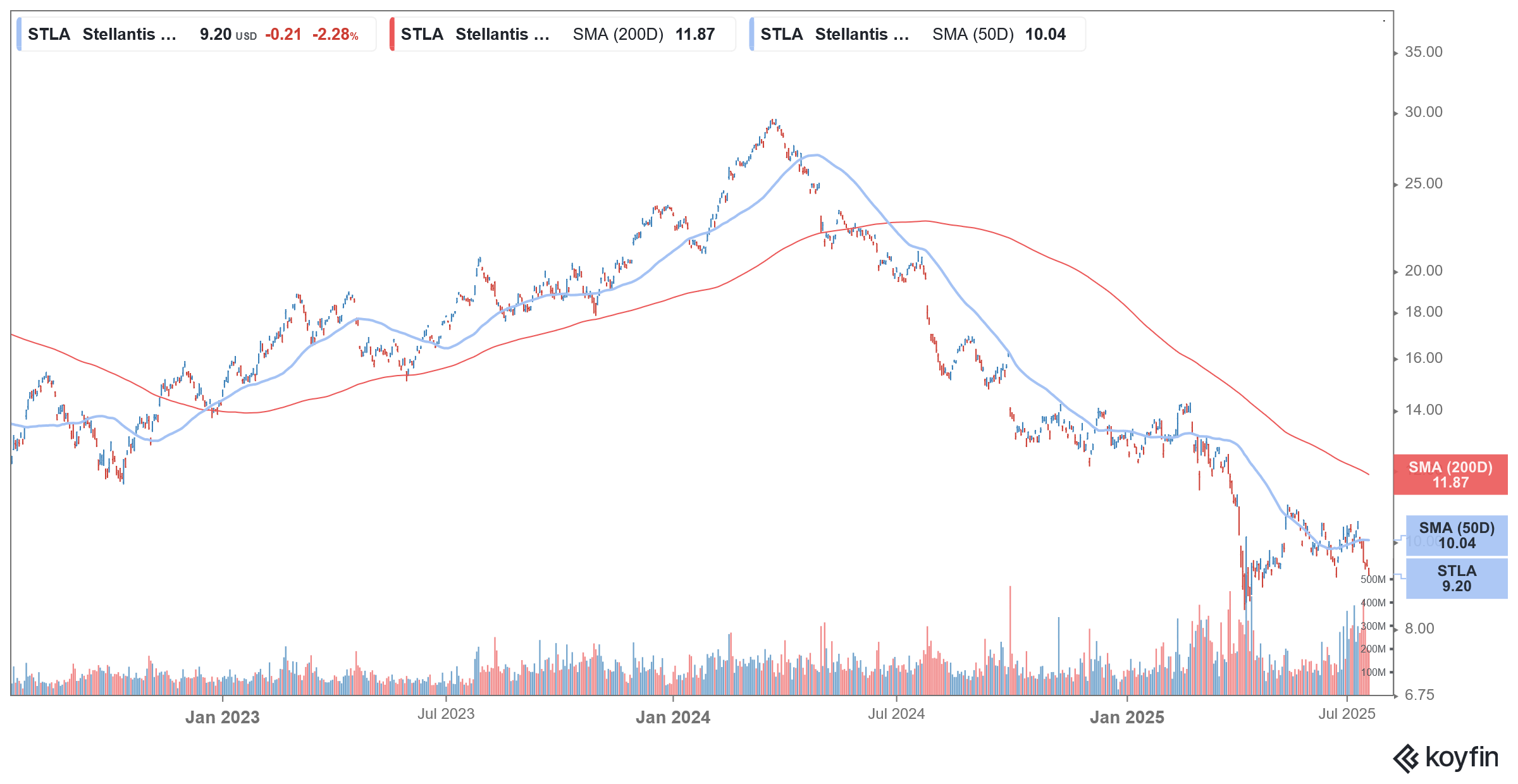Stellantis Warns of Massive First-Half Loss on Restructuring Costs and Tariffs
Please note that we are not authorised to provide any investment advice. The content on this page is for information purposes only.
Global automotive giant Stellantis N.V. (NYSE: STLA) expects a net loss of €2.3 billion (around $2.7 billion) for the first half of 2025. This grim outlook, announced in preliminary and unaudited figures, comes as the company grapples with the escalating impact of US tariffs, significant restructuring charges, and ongoing operational challenges.
Stellantis is booking approximately €3.3 billion in pre-tax net charges. These substantial charges are primarily related to program cancellation costs, platform impairments, and ongoing restructuring efforts aimed at streamlining operations and aligning production capacity with market demand. This includes the net impact of recent legislation eliminating the Corporate Average Fuel Economy (CAFÉ) penalty rate, which impacts emissions regulations in the US.
Stellantis Warns of Big First-Half Loss
Usually, Stellantis does not provide interim results. It, however, took the extraordinary step this time, considering the significant difference between actual earnings and analysts’ forecasts, which call for a profit in the first half of the year.
In his note, Jefferies analyst Philippe Houchois wrote that Stellantis’ preliminary update was “worse than consensus, but we think poor numbers were anticipated.”
Stellantis expects its consolidated shipments for the second quarter to fall 6% YoY to 1.4 million units. This follows a 9% decline in the first quarter. Overall net revenues for the first half are projected at €74.3 billion, a decrease from €85 billion in the same period last year. This decline is attributed to lower volume, adverse regional mix, and price normalization.
The implementation of a 25% tariff on all automobile imports by the US in April 2025 has significantly impacted Stellantis. The company estimates a direct €300 million hit from these tariffs in the first half alone, coupled with associated production losses as it adjusts its strategy. North American shipments in Q2 notably declined by approximately 25% year-on-year, primarily due to reduced manufacturing and shipments of tariff-affected imported vehicles, as well as lower fleet sales.
Tariffs Are a Headwind for Stellantis
Last year, Stellantis sold 1.2 million cars in the US, 40% of which were imported, primarily from Mexico and Canada. The automotive industry in North America is highly integrated, and tariffs are disruptive to the sector. Notably, Canada, Mexico, and the US were covered under the NAFTA (North American Free Trade Agreement), which Trump renegotiated in his first tenure. In July 2020, the USMCA (United States-Mexico-Canada Agreement) replaced NAFTA, which had come into effect in 1994. The USMCA is also scheduled for a review in July 2026.
For years, the US automotive industry benefited from lower production costs in Mexico, and global auto giants set up plants in that country. The tariffs are, however, set to negatively impact companies like Ford, GM, Stellantis, and Volkswagen as they all have manufacturing footprints in Mexico and Canada.
Stellantis Expects Second Half to be Stronger
Despite the challenging environment, Stellantis is emphasizing that this period represents the “early stages of our recovery plan.” The company is banking on a stronger second half of the fiscal year, anticipating that newly launched products will begin to deliver greater benefits. These new models include the Fiat Grande Panda, Opel/Vauxhall Frontera, and Citroën C3 Aircross, among others. Encouragingly, some regions like the Middle East & Africa and South America have shown growth in shipments, up 30% and 20% respectively, driven by increased volumes in key markets.
JPMorgan is also batting for an improved performance from Stellantis in the back half of the year. In its note, the brokerage said, “Results reflect the early stages of actions being taken to improve performance and profitability, with new products expected to deliver larger benefits in the second half of 2025.”
The full financial results on July 29 will provide more detailed insights into the extent of the challenges and the company’s detailed plan for navigating these headwinds.
Stellantis Appointed Filosa as CEO
In May, Stellantis appointed Antonio Filosa as its next CEO. Filosa is a company insider and was heading the company’s Americas business. His appointment comes months after former CEO Carlos Tavares abruptly stepped down in December 2024.
Amid the global uncertainty, Stellantis withdrew its annual guidance earlier this year. Other automakers have also been forced to cut their guidance, or withdraw it altogether, among others, due to uncertainty over President Donald Trump’s tariffs. General Motors, for instance, warned of a hit of up to $5 billion from the tariffs. It lowered adjusted pre-tax earnings guidance to between $10 billion and $12.5 billion, versus the previous guidance of between $13.7 billion and $15.7 billion.
Automakers Have Been Slashing Guidance Amid Tariff Woes
Similarly, it cut the adjusted automotive free cash flow guidance to between $7.5 billion and $10 billion, compared to the previous guidance of between $11 billion and $13 billion.
Volkswagen expects operating margins to be towards the lower end of its original guidance of 5.5-6.5%. Toyota, which is the world’s biggest automaker, expects profits to fall by a fifth this year, blaming the tariffs and a weaker US dollar.
Ford, however, suspended its 2025 guidance amid the tariff uncertainty. While it posted better-than-expected numbers for Q1, Ford warned of a $1.5 billion hit from the tariffs. Meanwhile, Ford said that if not for the tariffs, it was on track to meet its 2025 guidance of adjusted pre-tax earnings between $7 billion-$8.5 billion.
Global Automotive Industry Is Facing Turmoil
In 2021, Stellantis merged with Fiat Chrysler to create a global automotive behemoth. The company owns brands like Chrysler, Fiat, Peugeot, Ram, Jeep, Maserati, and Opel and is the fourth largest automaker globally. However, the company is not immune to the challenges that Western automakers are facing.
The automotive industry in the West is going through turmoil amid weak sales of ICE (internal combustion engine) cars. Another concern for legacy automakers has been their EV (electric vehicle) business. The sales of their EVs have been quite soft, while the losses are mounting.
There is also rising competition from Chinese companies, not only in China but also globally. Despite facing tariffs in several jurisdictions, including in Europe, Chinese automakers have been able to take market share from established players by offering attractively priced models.






